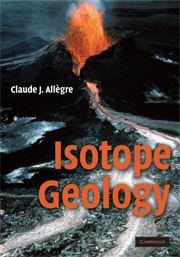Book contents
- Frontmatter
- Contents
- Preface
- Acknowledgments
- Isotopes and radioactivity
- The principles of radioactive dating
- Radiometric dating methods
- Cosmogenic isotopes
- Uncertainties and results of radiometric dating
- Radiogenic isotope geochemistry
- Stable isotope geochemistry
- Isotope geology and dynamic systems analysis
- References
- Appendix
- Further reading
- Solutions to problems
- Index of Names
- Subject Index
Preface
Published online by Cambridge University Press: 05 June 2012
- Frontmatter
- Contents
- Preface
- Acknowledgments
- Isotopes and radioactivity
- The principles of radioactive dating
- Radiometric dating methods
- Cosmogenic isotopes
- Uncertainties and results of radiometric dating
- Radiogenic isotope geochemistry
- Stable isotope geochemistry
- Isotope geology and dynamic systems analysis
- References
- Appendix
- Further reading
- Solutions to problems
- Index of Names
- Subject Index
Summary
Isotope geology is the offspring of geology on one hand and of the concepts and methods of nuclear physics on the other. It was initially known as “nuclear geology” and then as “isotope geochemistry” before its current name of isotope geology came to be preferred because it is based on the measurement and interpretation of the isotopic compositions of chemical elements making up the various natural systems. Variations in these isotope compositions yield useful information for the geological sciences (in the broad sense). The first breakthrough for isotope geology was the age determination of rocks and minerals, which at a stroke transformed geology into a quantitative science. Next came the measurement of past temperatures and the birth of paleoclimatology. Then horizons broadened with the emergence of the concept of isotopic tracers to encompass not only questions of the Earth's structures and internal dynamics, of erosion, and of the transport of material, but also problems of cosmochemistry, including those relating to the origins of the chemical elements. And so isotope geology has not only extended across the entire domain of the earth sciences but has also expanded that domain, opening up many new areas, from astrophysics to environmental studies.
This book is designed to provide an introduction to the methods, techniques, and main findings of isotope geology. The general character of the subject defines its potential readership: final-year undergraduates and postgraduates in the earth sciences (or environmental sciences), geologists, geophysicists, or climatologists wanting an overview of the field.
- Type
- Chapter
- Information
- Isotope Geology , pp. ix - xPublisher: Cambridge University PressPrint publication year: 2008



